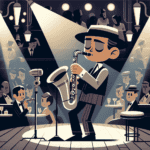When you think of klezmer music, one name that stands out is none other than Don Byron. Known for his significant impact on the genre, Byron's unique style and masterful clarinet playing have made klezmer music more accessible and exciting to modern audiences.
Klezmer music, with its rich melodies and vibrant rhythms, has long been a staple of Jewish cultural expression. Originating in Eastern Europe, this genre was traditionally performed at celebrations and festivities. The clarinet, with its expressive range and emotive power, naturally became a central instrument in klezmer ensembles. And that's where Don Byron comes in, blending his classical training with a deep appreciation for klezmer's roots.
Byron's Journey into Klezmer
Byron's journey into klezmer began when he stumbled upon old records and got captivated by the genre's soulful sounds. What makes Don Byron's approach to klezmer so special? It's his ability to infuse traditional melodies with contemporary jazz elements. This fusion not only honors the past but also breathes new life into the music. His renditions of classic klezmer tunes are not mere reproductions; they are reinterpretations that carry his distinct musical signature.
| Key Elements of Byron's Klezmer Style | Description |
|---|---|
| Microtones | Skillful use of notes between standard Western scale pitches |
| Jazz Fusion | Blending traditional klezmer with contemporary jazz elements |
| “Funky Glissandi” | Byron's signature technique showcasing virtuosity and innovation |
| Improvisation | Spontaneous, intricate passages woven with familiar klezmer motifs |
Byron's Techniques and Their Importance
One of the techniques Byron is known for is his skillful use of microtones. In klezmer music, the ability to play notes between the standard pitches of the Western scale can add a level of expressiveness that is truly unique. Byron's precise control over these intonations creates hauntingly beautiful and deeply resonant sounds that are a hallmark of his klezmer performances. “Funky Glissandi,” as he often calls them, showcase his virtuosity and innovative spirit.
For those looking to emulate Byron's style, mastering the clarinet's dynamic range is key. Klezmer music often requires quick transitions from soft, subtle passages to loud, exuberant outbursts. Practicing long tones and incorporating dynamic exercises into your routine can help build the control needed to handle these shifts smoothly.
The Importance of Breath Control
Breath control is another important aspect of playing klezmer, especially in Byron's energetic renditions. Circular breathing, a technique that allows you to maintain a continuous sound by breathing in through the nose while pushing air out through the mouth with air stored in your cheeks, is particularly useful. Though challenging, learning circular breathing can greatly improve your ability to play those lengthy, flowing klezmer phrases without interruption.
Exploring Byron's Discography
Byron's discography offers a wealth of material for any clarinetist interested in klezmer. Albums like “Don Byron Plays the Music of Mickey Katz” and “A Fine Line: Arias and Lieder” provide excellent examples of how he blends traditional klezmer with elements of classical music, jazz, and beyond. These recordings not only highlight his technical proficiency but also his deep emotional connection to the music.
Choosing the Right Instrument
While Don Byron has worked with many brands, the Martin Freres clarinets, known for their warm tone and reliable construction, perfectly complement his klezmer artistry. As you explore klezmer music, it's helpful to find an instrument that matches your style and sound goals.
The Value of Live Performances
To truly grasp the essence of Byron's klezmer, attending live performances or watching videos of his shows can be incredibly inspiring. His stage presence, interaction with fellow musicians, and sheer passion for the genre are contagious. Observing his fingerings, embouchure, and phrasing in a live setting can provide real-time insights that recordings alone may not capture.
The Art of Improvisation in Klezmer
Klezmer music, much like jazz, thrives on improvisation. Don Byron's solos often weave stories, combining familiar klezmer motifs with spontaneous, intricate passages that keep audiences on the edge of their seats. For budding clarinetists, practicing improvisational techniques and learning to trust your musical instincts are important steps. Start with simple variations on traditional klezmer scales, then gradually build up to more complex improvisations as your confidence grows.
Engaging with the Klezmer Community
Engaging with the klezmer community can also be a rewarding experience. Many musicians love to share their knowledge and passion, and participating in klezmer workshops or jam sessions can provide practical feedback and new perspectives. Emulating Byron's musical journey means immersing yourself fully in the culture and traditions of klezmer music, while also bringing your voice to the table.
So, whether you're a seasoned clarinetist or just starting out, exploring Don Byron's klezmer can open up new dimensions of expression and challenge your skills in rewarding ways. Discover, practice, and let the soulful tones of klezmer inspire your next musical adventure!







